Travelling to New France from St. John’s, Newfoundland involved a day of travel: one drives on the Trans Canada Highway across the Avalon peninsula to the Burin peninsula, then turns left at Goobies onto Highway 210. One keeps driving on it, until one reaches Marystown. A right turn onto Highway 220, leads to the port of Fortune, which is where the SPM ferries dock in Canada. From there those with vehicles reverse onto the ferry, so they can drive forward when they arrive in Saint-Pierre. Altogether, this involves 363 km and almost 4 hours of driving. The ferry from Fortune to Saint-Pierre is about 45 km, and takes another 1.5 hours.
If one is fortunate in Marystown, one meets the Little Green Devil, a 1965 Rambler American 2-door sedan. This model, and many others in the Rambler lineup, was designed by Dick Teague (1923 – 1991). From my perspective, it is Teague’s most successful design. These vehicles are known for their smooth ride, despite their compact size. WhiIe I would not criticize anyone’s vehicle preferences (with the possible exception of motorcycles), i prefer utility vehicles ( vans and station wagons). Vehicle solidity is my focus. Thus, I prefer vehicle construction incorporating a frame around every door, in contrast to flimsier hardtop models. Despite having a driving license since Tuesday, 1965-01-05, I have owned only four vehicles, including one jointly with my wife, Trish.
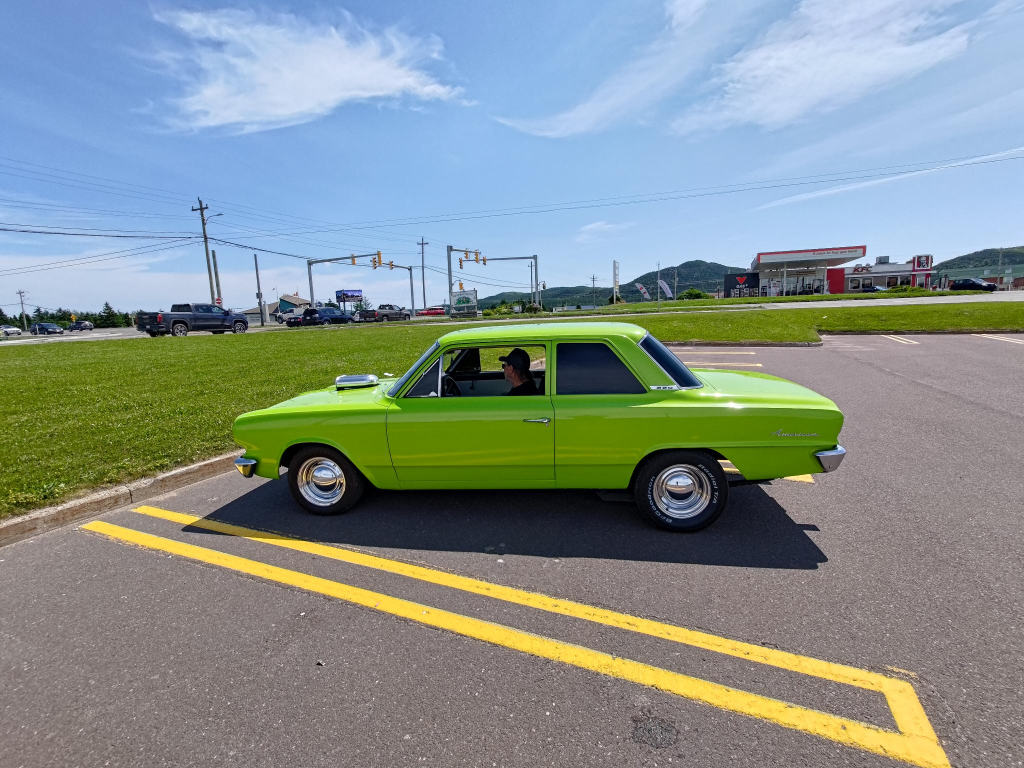
At Fortune, we were able to eat a chicken dinner at Mary Brown’s. This was our first experience of this fast food chain. Originally it was named Golden Skillet, the first location was at St. John’s Avalon Mall. However, the owners were forced to rename the establishment for legal reasons. Currently, there are over 300 locations across Canada.
After that meal we picked up our ferry tickets, then went next door to arrange to park our rental car for two days on the outskirts of town. We were driven back to the ferry terminal. The 1.5 hour ferry ride was uneventful. There was little to see apart from waves on the ocean, despite having window seats.
St. Pierre
The Overseas Collectivity of Saint-Pierre and Miquelon = Collectivité d’outre-mer de Saint-Pierre et Miquelon (referred to hereafter as SPM) has a population of about 6 000, and occupies an area of 242 km2 on eight islands. It is located about 19 km west of Point May on the Burin peninsula.
Two almost identical ferries provide for much of the transportation needs of the archipelago. These are the blue hulled Nordet and the red hulled Suroît. The vessels are 56.7 m long, with a 768 UMS tonnage. Both entered service in 2019. They are named after a northerly, and southerly wind, respectively.
Compared to the casual, and often inappropriate dress of deck crew on Norwegian ferries, the deck crew of these French ferries were dressed for any emergency. They were equipped with helmets, hi-vis vests, life preservers, gloves and safety shoes.
After landing in St. Pierre, we passed through French immigration and were able to enter France. We walked through the town, until we found our bed and breakfast, where we had rented two rooms. This was followed by yet more walking around the town. The gradient was intermediate to my two reference points. It was steeper than most places in Inderøy, Norway, but not as steep as the worst hills in New Westminster, British Columbia, Canada.
St. Pierre, the island and village is named for St. Peter, the patron saint of fishers, net makers and ship builders. He was born Simon, possibly Simeon. Both he and his brother Andrew were themselves fishers, later, they became two of the twelve apostles. Details of Peter’s life are vague, although he was the Bishop of Rome = Pope, from 30 AD to his death 64 – 68 AD, crucified by Nero (37 – 68).
Miquelon
The name Miquelon is probably of Basque origins, referring to Big Michael, given to the island by Basque Martin de Hoyarçabal in his navigational pilot for Newfoundland, Les voyages aventureux du Capitaine Martin de Hoyarsabal, habitant du çubiburu (1579). It is 110 km2. Langlade is said to be an adaptation of l’île à l’Anglais = Englishman’s Island. It is 91 km2.
While Saint-Pierre is far too urban for my tastes, with a population over 5 000, and an area of 26 km2, Grande Miquelon is appropriately populated (ca. 700 people) and sized (110 km2). If I lived there, I am sure that I would want to spend much of my time in the wilderness of Langlade.
Air Travel
One of the main reasons for wanting to visit SPM was to experience flights with Air Saint-Pierre. We were going to fly both ways on inter-island flights between Saint-Pierre and Miquelon.
On Monday, 2025-07-23, we left our bed and breakfast at 07:30 and walked to Aéroport de Saint-Pierre = Saint-Pierre Airport (FSP), a regional airport located south of Saint-Pierre. It opened in 1999 and consists of four buildings excluding the control tower. It replaces an older airport that opened in 1965. The new 08/26 runway is 1 800 m long, while the old 11/29 runway was 1 250 m, not long enough for most commercial aircraft.
The passenger terminal at 2 200 m2, is large given the traffic.
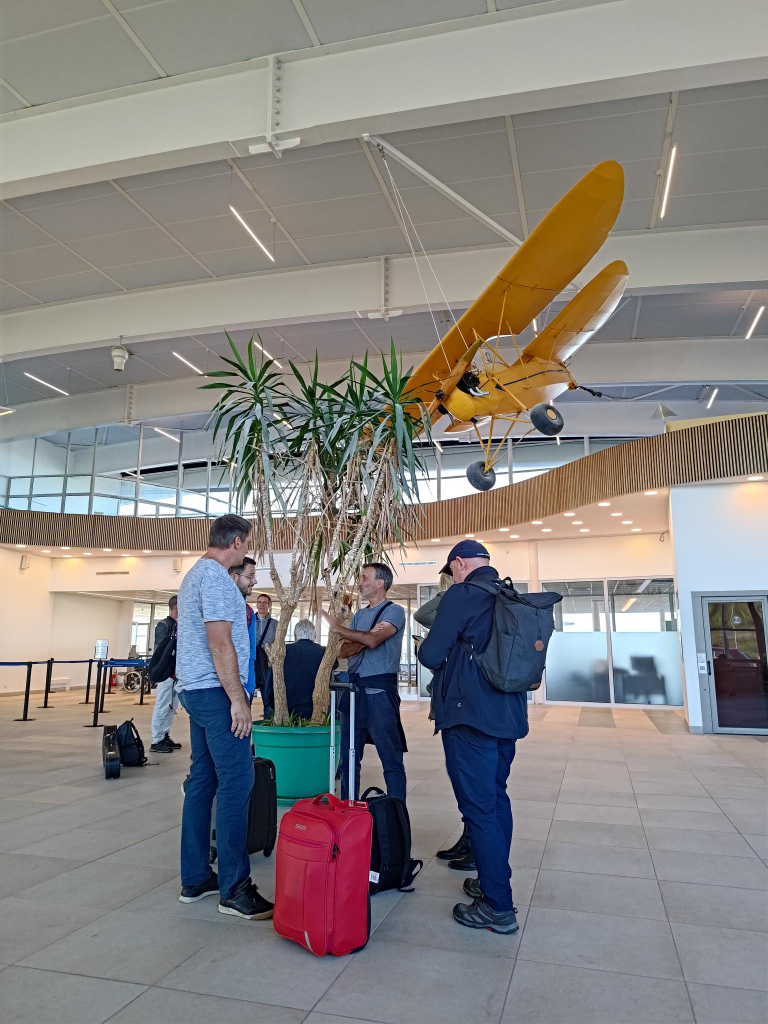
We boarded our aircraft at about 08:30, without any form of security check. It took about 10 minutes to get the aircraft in condition to fly. After about 15 minutes in the air, we were landing at Aéroport de Miquelon = Miquelon Airport (MQC), the regional airport on Miquelon Island. The 12/30 runway is only 1 000 m long, suitable for the Reims-Cessna F406 Caravan II machine, but nothing much larger.
Our return flight was delayed, because the number of passengers exceeded the number of seats available. Thus, we had to wait until the plane flew to Saint-Pierre, then returned to pick us up. Alasdair was happy that he was issued seat 1A for both flights. I was assigned 1B for both flights.
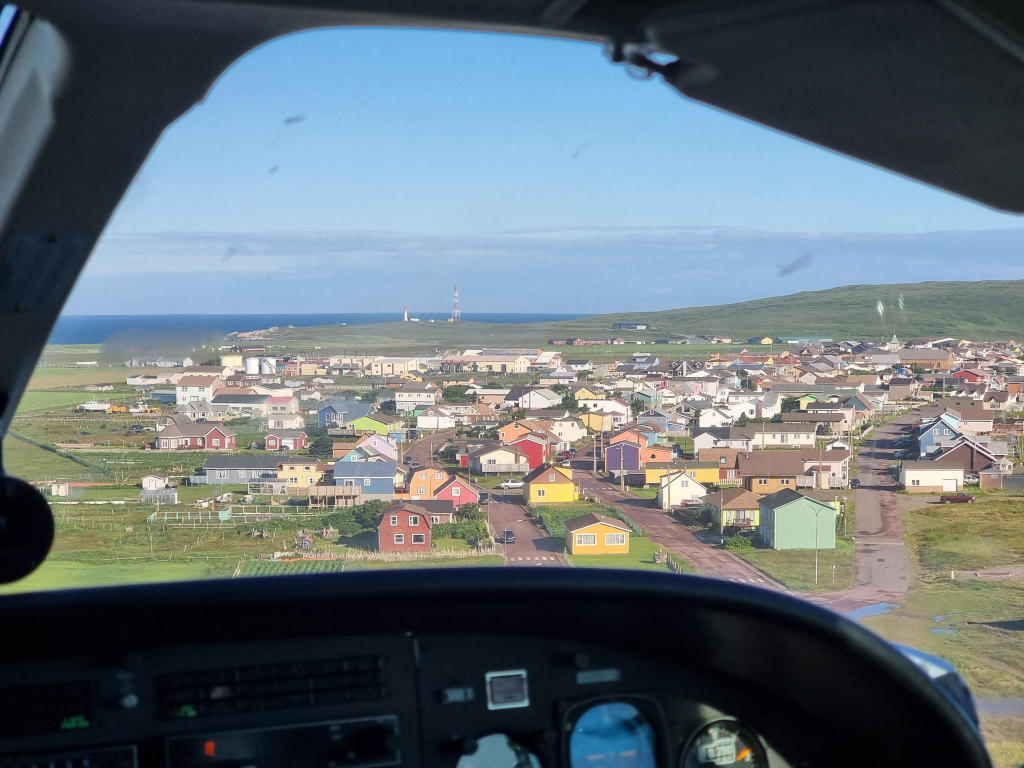
Flying close to the village of Miquelon, on a landing approach. Photo: Alasdair McLellan.
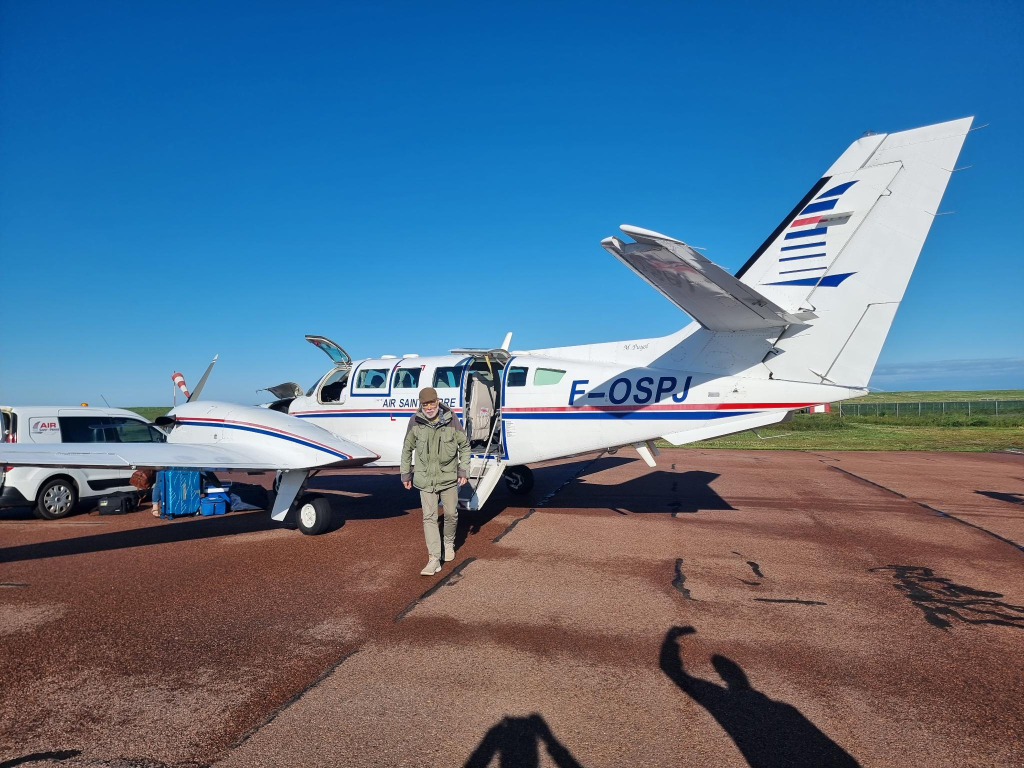
Here I am emerging as the last passenger out of our aircraft, a Reims-Cessna F406 Caravan II of unknown vintage. Photo: Alasdair McLellan.
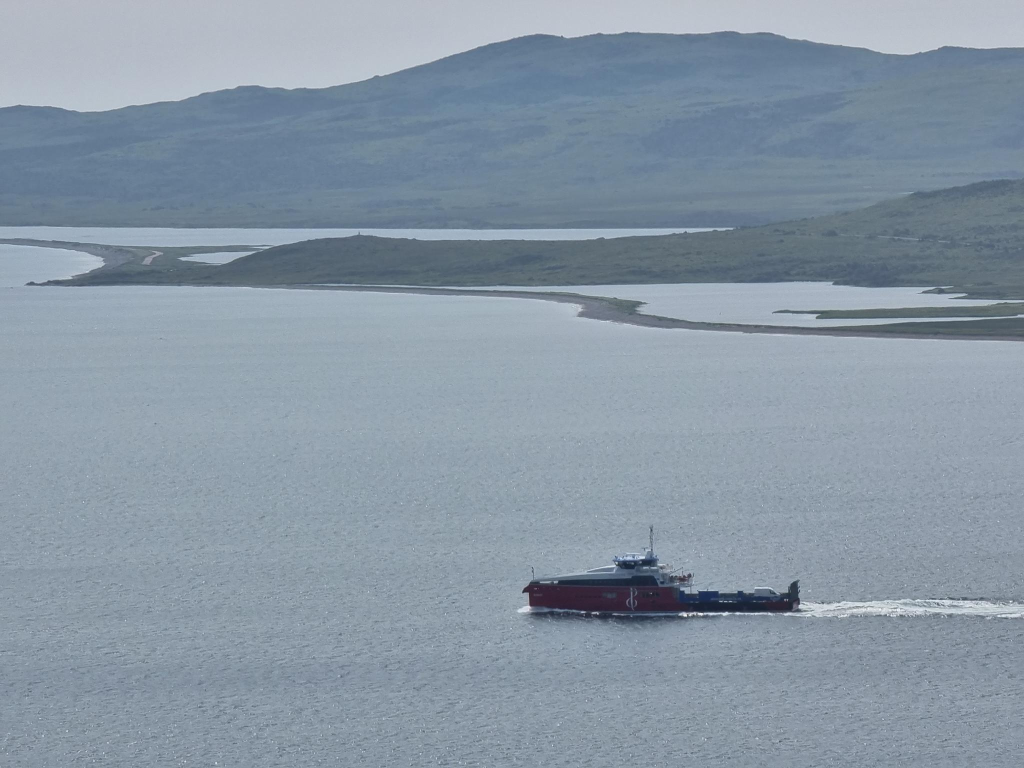
The Suroît off Miquelon.
I have experience with ferries, of various types, especially from six years with weekly commutes in Norway between Molde and Inderøy, usually involving four ferries each week. I appreciate their efficiency, especially in docking, unloading and loading vehicles. However, I note the lack of crew safety equipment.
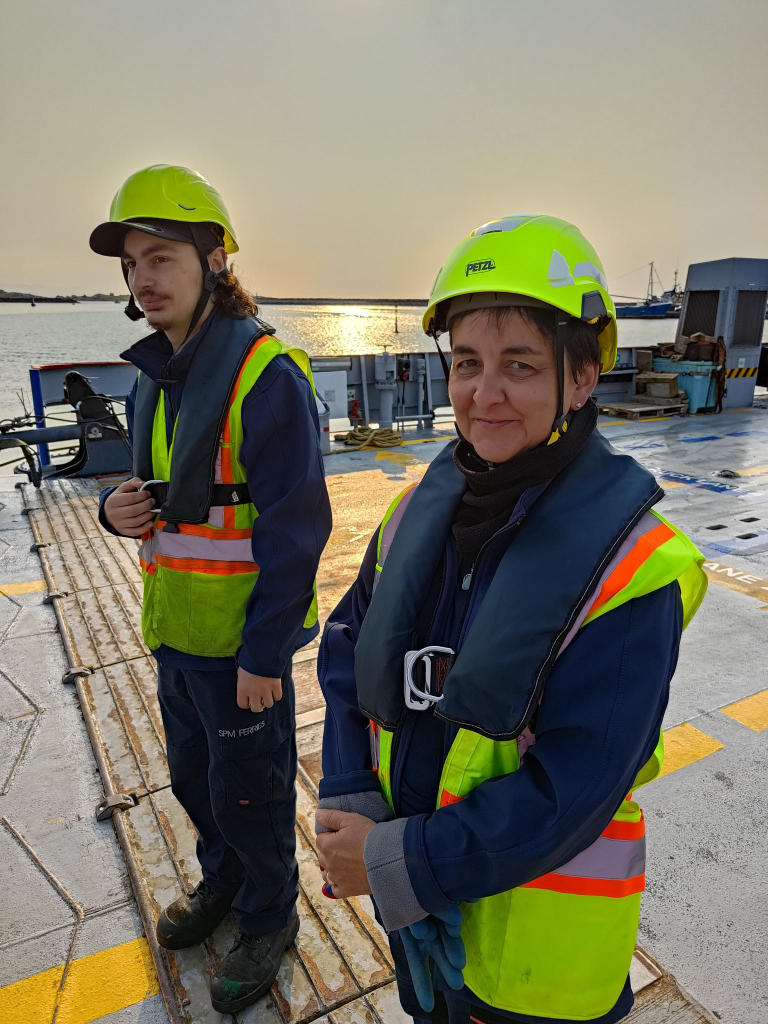
Here, the deck crew of Suroît are dressed for any emergency. They are equipped with helmets, hi-vis vests, life preservers, gloves and safety shoes. Later, I talked with Fréderique Ragot, about her work.
Visiting remote airports and train stations is one of the perks of being the parent of someone who studied transportation economics, then took a B.Com. with a marketing specialization, before turning to history, ending with a M.A. and a thesis about the development of a now-defunct Norwegian airline.
Regional Influences
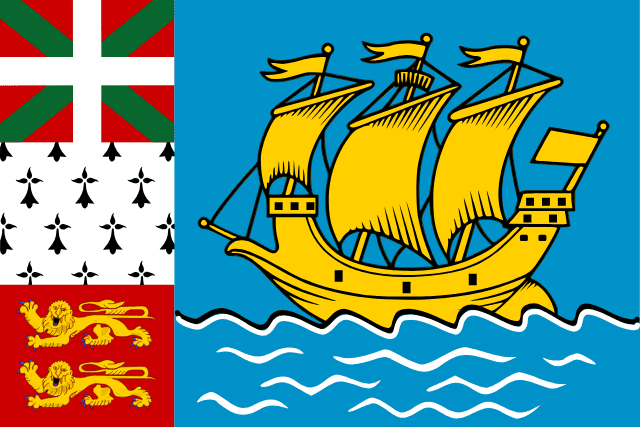
While the official flag of SPM is the French flag, an unofficial SMP flag is also used. Because of my interest in flags, often collecting them from places I visit, I wanted to buy a SPM flag. This proved impossible. Much of the flag contains elements found on the SPM coat of arms. Along the hoist, from bottom to top, are the flags of Normandy, Brittany and, in the uppermost position, the Basque Ikurriña, officially described as a white cross over a green saltire on a red field. Basque nationalists Luis Arano (1862 – 1951) and his brother Sabino (1865 – 1903) developed the Basque flag. Its neologistic name comes from ikur ‘mark, sign’ (itself a neologism extracted from irakurri ‘to read’). These are the places that contributed most of the population of SMP.
The yellow ship on the flag represents the Grande Hermine, the carrack which brought Jacques Cartier (1491 – 1557) to Saint Pierre on 1535-06-15.
World War II
Yet, another reason for this trip to this part of the world, was to understand the situation my parents encountered when they were stationed with the Royal Canadian Air Force, in Newfoundland, for a large part of World War II. Newfoundland was not yet part of Canada, but British territory. SPM was (and still is) part of France. Decisions often involved four countries, with a theoretically neutral USA wanting to make decisions.
The Third French Republic had begun World War II in 1939-09-03 on the side of the Allies. On 1940-05-10 it was invaded by Nazi Germany. Paul Reynaud (1878 – 1966) resigned as prime minister and was replaced by Philippe Pétain (1856 – 1951). On 1940-06-22, Pétain signed an Armistice that created Vichy France that, on paper, existed from 1940-07-10 to 1944-08-09. Vichy was the seat of government, about 400 km south of Paris.
The Vichy government was authoritarian, antisemitic and, somewhat later, anti-Soviet. Yet, it never joined the Axis powers and was formally at war with Germany. In practice, it was collaborationist. SPM authorities had sworn their allegiance to the Vichy French government.
There were concerns in Newfoundland (NL), Britain and Canada, that the Axis powers might use SPM as a base of operations, offering German submariners an excellent position to re-supply and coordinate attacks upon Allied convoys. Wireless communication and transatlantic cables allowed the islands’ authorities the opportunity to transmit vital information to Vichy France and onwards to German submarine crews about weather conditions, the movements of Allied warships and convoys. There was also concern that local fishery products could be sent to Germany through mainland France.
NL wanted a pre-emptive invasion of SPM. Canada was against this for fear of offending USA. As the Battle of the Atlantic reached Canadian waters in 1941, The Canada–United States Permanent Joint Board on Defence had unanimously agreed that the existence of an uncontrolled and high-powered wireless transmitting station on SPM constituted a threat to the interests of Canada and USA. Yet, USA opposed the use of force to take control of SPM.
Charles de Gaulle (1890 – 1970), Chairman of the (Free) French National Committee 1940-06-18 to 1944-06-03 asked Admiral Émile Muselier (1882 – 1965) to investigate the possibility of invading the islands, then ordered their capture.
On 1941-12-23, a French flotilla, the submarine Surcouf and three corvettes, Mimosa, Aconit and Alysse, sailed from Halifax under the pretense of a training mission. It arrived off Saint-Pierre and disembarked 230 armed sailors. They met no resistance and captured the island in only 20 minutes. Some sources state that Miquelon was captured the same day, others the following day. The Free French authorities organized a plebiscite on 1941-12-25, but only males over 18 years were given a choice of “rallying to Free France or collaborating with Axis powers”. Almost 98 per cent voted in favour of Free French administration.
I find it noteworthy that the French named their largest submarine after a slave trader and privateer, Robert Surcouf (1773 – 1827).
The US Secretary of State, Cordell Hull (1891 – 1955), called the capture of SPM a violation of the Monroe Doctrine. He wanted to prohibit French citizens exercising their democratic rights. He wanted SPM to restore its Vichy government. The Monroe Doctrine, first articulated 1823-12-02, is a United States foreign policy position that opposes European colonialism in the Western Hemisphere. Any intervention in the political affairs of the Americas by foreign powers is a potential hostile act against the USA.
Despite Hull’s protests, this incident was soon forgotten. The Japanese attack on Pearl Harbor, 1941-12-07, and the declaration of war on the USA, by both Japan and Germany, meant that Vichy France had become an enemy.
In the 1930s, many Americans were isolationists, not wanting to involve themselves in wars. Others were sympathetic to the Nazi cause. The situation has not dramatically changed in recent years, with Donald Trump wanting the USA to imitate its past, and for it somehow to become great, again. It is instructive to look at the demographics of the Capitol insurrectionists in Washington D.C. on 2020-01-06. They were predominantly white, male, aged 30+, trained and working as professionals. They were not the downtrodden.
Greatness is not measured by the number of billionaires. I am a limitarian, a believer in putting strict limits on personal wealth, with a maximum vastly below a billion $/ €/ £. One percent of that amount should be sufficient for everyone.
Mountains
Many mountains in the Canadian Rocky mountains were named for French generals prominent in World War I in 1919. Mount Pétain was one of these, located on the border of the Canadian provinces of Alberta and British Columbia on the Continental Divide. Geoffrey Taylor (1952 – 2020), a former University of Calgary professor of infectious diseases, campaigned from 2016 to his death, to remove the name of the Nazi collaborator from the mountain. In 2019, Alberta rescinded Pétain’s name from the Alberta side of the border. In 2022, British Columbia also rescinded the name, leaving the mountain and other features previously associated with Pétain, nameless.
Time
Clocks are an important technology for the world. I appreciate Sandford Fleming’s (1827 – 1915) promotion of 24 worldwide standard time zones, a prime meridian, and use of the 24-hour clock. He saw these as necessary elements for communicating time accurately. I am also glad that there is an International Telecommunications Union (ITU), that has created a world time standard, Coordinated Universal Time (UTC). A weblog post on the ITU is scheduled for its 160th anniversary, 2025-05-17. Here many other aspects of time will be discussed.
In this post, I would like to restrict myself to expressing a minor, but unnecessary, irritation with Newfoundland. At the same time, I would like to thank SPM for not following in its wayward footsteps. This irritation can be expressed as Newfoundland and Labrador, having a time that offsets those of a time zone, by 30 minutes.
This post is being published on Ukrainian independence day = День Неза лежності України, 2024-08-24, in commemoration of the Declaration of Independence in 1991.

